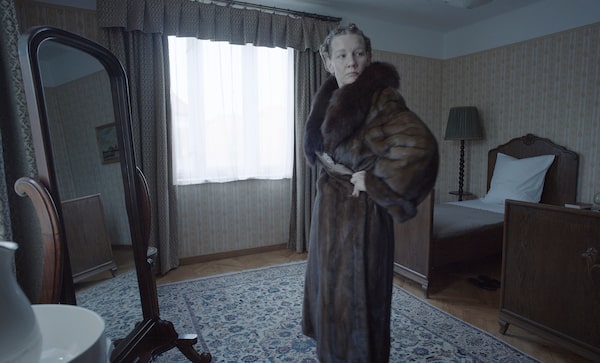
Sandra Hüller in a scene from The Zone of Interest.The Associated Press
Can you tell the story of Auschwitz without showing the horrors of Auschwitz? Jonathan Glazer believed he could, and his artistic gamble has paid off: His film, The Zone of Interest, was recognized Tuesday with five Academy Award nominations, including best picture and best director.
The movie is as polarizing as any this year. The Globe and Mail’s Barry Hertz called it “the best and most important film of 2023.” The New York Times called it “hollow”; the New Yorker said it was “Holokitsch.” Some have called it out for failing to show what happened at the extermination camp: the mass gassing of 1.1 million people, mostly Jews – including children – and the burning of bodies in custom-made crematoria. The film makes for a sanitized Holocaust, the argument goes.
I disagree.
To begin with, I don’t think it’s possible to actually show the hell of that place, no matter how graphic the depiction. It does eventually show the gas chamber, but in a most unexpected way.
The film is chilling and powerful, but prior knowledge is essential. If you don’t know what went on in Auschwitz, nothing that goes on at the villa where its commandant Rudolf Höss and his family lived will matter.
That is the film’s focus: the Höss family, living in their dream house at the edge of Auschwitz, where Christian Friedel’s Rudolf works, doing unspeakable things (which remain for the most part unspoken, other than euphemistically) before coming home to read bedtime stories to his children.
Meanwhile, his wife Hedwig, played by Sandra Hüller, enjoys the spoils of genocide: a fur coat, a lipstick.
This domestic portrait exemplifies the banality of evil, as Hannah Arendt famously put it. The casual, cruel complicity of living next to a murder factory – and loving it! – is the point. In a different context, minus the location and the plundering – this could be any family.
Mrs. Höss has made choices. She twirls in front of the mirror in her stolen fur; she gossips with friends in the kitchen as if people weren’t being murdered on the other side of the yard’s protective walls. She threatens to turn a Polish housekeeper to ash for some minor transgression. Meanwhile, slave labourers spread actual ash onto her garden to fertilize it.
In a work meeting, Mr. Höss examines designs for a new-and-improved gas-chamber process with the aim of killing more efficiently. That is never said out loud. Instead, they talk about “the loads.”
The soundtrack hints eerily at what is happening in the camp. “The horrors of life over the wall were going to be represented sonically,” Mr. Glazer told NPR. “I think those images … are sort of seared into our minds anyway. And so it seemed pointless to try and recreate them or re-enact them.”
The script is a departure from the source material. Martin Amis’s novel of the same name is a more caustic, black-humour enterprise. In one passage, Auschwitz commandant Paul Doll (a fictionalized version of Rudolf Höss) complains about his workload: “As if I didn’t have ‘enough on my plate,’ ” he grumbles.
Unlike the novel, Mr. Glazer’s film zeroes in on the family. But it’s not untrue to the book.
“It was just when I learned in detail about the SS men having their families there in Auschwitz,” Mr. Amis said when I asked about the origin of his idea in a 2014 interview. “I think it’s an incredible fact that in fact the commandant at Auschwitz had his five children there. ... They must have had a sort of simulacrum of a kind of social life. They must have played along as if there was some reasonable social dimension to what they were doing. And that had always sort of bothered me.”
Now, something personal: there is a meeting depicted in the film where Nazi higher-ups negotiate over how many Jews to gas versus how many to preserve as slave labour for German companies. Would 20 per cent do it?
My mother arrived in Auschwitz in August, 1944. Three months later, she was shipped to a satellite camp of Buchenwald in the German town of Lippstadt to be a slave labourer making munitions. It was horrible – but it was better than Auschwitz. And that saved her life.
Watching that scene was electric and excruciating. It was my history – the reason I’m alive.
Rudolf Höss was hanged, but his complicit wife remarried and lived in the U.S., until her death in 1989. I found information on an obituary website: “Help us celebrate Hedwig!” it said.
International Holocaust Remembrance Day is this Saturday, the anniversary of the Auschwitz liberation. I’ve been thinking a lot about this film, and about Mrs. Höss. I wonder: when she died, did she have a fur coat?